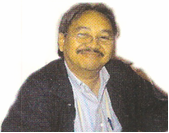| By Jonathan Fildes Science and technology reporter, BBC News |
 The government of Nigeria is still assessing the scheme |
Walter Bender of One Laptop per Child (OLPC) said politicians were unwilling to commit because "change equals risk".
But, he said, there needed to be a "dramatic change" because education in many countries was "failing" children.
In an interview with the BBC, Nigeria's education minister questioned the need for laptops in poorly equipped schools.
Dr Igwe Aja-Nwachuku said: "What is the essence of introducing One Laptop per Child when they don't have seats to sit down and learn; when they don't have uniforms to go to school in, where they don't have facilities?"
"We are more interested in laying a very solid foundation for quality education which will be efficient, effective, accessible and affordable."
The previous government of Nigeria had committed to buying one million laptops.
Dr Aja-Nwachuku said he was now assessing OLPC alongside other schemes from Microsoft and Intel.
![]()
![]() There is still a concerted misinformation campaign out there
There is still a concerted misinformation campaign out there ![]()
"We are asking whether this is the most critical thing to drive education."
But speaking separately to BBC News, Professor Bender said: "We think that change has to be dramatic."
"You've got to be big, you've got to be bold. And what has happened is that there has been an effort to say 'don't take any risks - just do something small, something incremental'."
"It feels safe but by definition what you are ensuring is that nothing happens."
Winds of change
OLPC was started in 2002 by Nicholas Negroponte, a professor at the Massachusetts Institute of Technology.

It aims to put thousands of low-cost laptops, known as the XO, in the hands of children around the world.
The machines are planned to cost $100 and have been especially designed for use in remote and harsh environments where there is little access to electricity or the internet.
But getting the project off the ground has proved difficult.
Professor Negroponte has had high profile run-ins with major technology firms.
He told an audience at a Linux event: "if I am annoying Microsoft and Intel then I figure I am doing something right."
Microsoft head Bill Gates had questioned the XOs design, particularly the lack of hard drive and its "tiny screen".
But recently, the firm announced that it was working on a version of Windows XP that would run on the pared down machines.
![]()
![]() The price will come down as the numbers go up. It will take time but it will happen
The price will come down as the numbers go up. It will take time but it will happen ![]()
"We are spending a non-trivial amount of money," Microsoft's Will Poole told Reuters.
Earlier this year, Professor Negroponte also accused Intel of selling its own cut-price laptop - the Classmate - below cost price to drive him out of markets. He said that Intel "should be ashamed of itself" and said its tactics had hurt his mission "enormously".
Within weeks it was announced that Intel had joined the board of OLPC amid speculation that the firm was unhappy about the XO using a processor from its main rival AMD.
'Small thinking'
Although these episodes now appear to be behind OLPC, Professor Bender said there was still an "aggressive" effort to undermine the charity.

"There is still a concerted misinformation campaign out there," he said.
Mr Bender said he would not speculate on who was behind the alleged campaign.
"Wherever it is coming from, it exists," he told BBC News.
But he said the main problem for OLPC was dealing with conservative politicians.
"Change equals risk especially for politicians. And we are certainly advocating change because the [education] system is failing these children," he said.
"It has not been that processor versus that processor or that operating system versus that operating system - it's been small thinking versus big thinking. That's really the issue," he said.
Sales target
Originally, the laptops were to be sold to governments in lots of one million for $100 apiece.
Over time, however, the project has dropped the minimum number of machines that can be ordered, leading some to speculate that governments were not buying into the scheme.
![]()

![]()
The project also recently launched an initiative to allow citizens of North America to buy two machines at a time; one for themselves and one for a child in a developing country.
But Mr Bender said the shift was because of a better understanding of how to distribute smaller numbers cheaply and effectively, rather than a lack of orders.
"Part of it was our understanding of how the supply chain was going to work and having enough flexibility in the supply chain to make it work with a small number," he said.
"The big numbers were really about how you get this thing started not how you make it work in the long term.
"That was always going to be about supporting any good idea that comes along. And we've been able to get it started without the big top down numbers so we are off and running."
Developing tool
Since the scheme was first announced in 2002 there have been reports of several countries signing up to it.
Both Nigeria and Libya were reported to have ordered more than one million laptops.

Other countries including Thailand and Pakistan had also placed orders, according to reports.
But recently, OLPC revealed it had just taken its first order for 100,000 of the machines, placed by the government of Uruguay.
"Uruguay is first then it will be Peru, Mexico, Ethiopia then we are going to be doing stuff in Haiti, Rwanda and Mongolia," said Mr Bender.
In addition, he said, OLPC had done a deal with Birmingham, Alabama, in the US, to provide the laptop for schools in the city.
"The numbers of countries where we have trials set up is also increasing," he said.
Tests were also going on in the Solomon Islands, Nepal and India, a country that had previously shunned the scheme.
The Indian Ministry of Education had previously dismissed the laptop as "pedagogically suspect", whilst the Education Secretary Sudeep Banerjee said the country needed "classrooms and teachers more urgently than fancy tools".
Tipping point
The first machines will cost almost double the $100 originally planned.
The high price has been blamed on the increasing cost of the raw materials for the components inside the XO. Each machine currently costs $188.
"The price will come down as the numbers go up. It will take time but it will happen," said Mr Bender.
The manufacturer of the laptop - Quanta - recently revealed it had started mass production of the machines, after a number of delays.
Previously, OLPC had said it needed three million orders to make production feasible.
Professor Negroponte said it was an important milestone that had been reached despite "all the naysayers".
"We're not turning back - we have passed the point of no return," said Mr Bender. "It is happening."





![[Screenings]](http://online.wsj.com/public/resources/images/PJ-AL202_pjNEWB_20071029191252.gif)




































